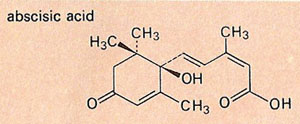abscission

In vascular plants, abscission is the shedding of leaves, flowers, fruits, or stems at the end of a growing season, as the result of formation of a layer of specialized cells at the base of the stalk and the action of the hormone abscisic acid and other growth-inhibiting substances. In the abscission layer, the parenchyma cells become separated from one another through dissolution of the middle lamella. Wind and rain help dislodge the parts separated by abscission layers.
Abscission is essential for the survival and growth of plants, as it enables them to conserve energy and resources by shedding organs that are no longer useful.
Abscission occurs when the plant forms a special layer of cells at the base of the organ that is to be shed. This layer, called the abscission layer or abscission zone, separates the organ from the plant body and causes it to fall off or be easily removed. The process of abscission is controlled by hormones and other signaling molecules, and is influenced by various environmental factors such as light, temperature, and moisture.
Leaf abscission is a common type of abscission that occurs in many plants, and is important for the plant's ability to adjust to changes in the environment. For example, deciduous trees shed their leaves in the fall in response to shorter days and cooler temperatures, in order to conserve energy and resources during the winter months. Flower and fruit abscission are also important for the reproduction and dispersal of plants.
Abscission can also occur in response to stress or damage, such as insect infestation, disease, or mechanical damage. In these cases, the plant may shed organs in order to conserve resources and protect itself from further harm. Understanding the mechanisms and factors that control abscission is an important area of research in plant biology, as it has important implications for the growth and development of plants, as well as for agriculture and horticulture.
Abscisic acid
Abscisic acid, formerly known as abscisin II or dormin, is a growth-inhibiting plant hormone (a sesquiterpene). Abscisic acid is present in a variety of plant organs, including leaves, buds, fruits, seeds, and tubers. It promotes senescence and abscission of leaves, and induces dormancy in buds and seeds. It is antagonistic to growth-promoting hormones.


